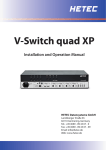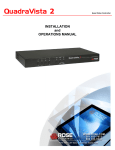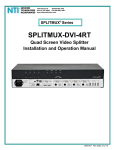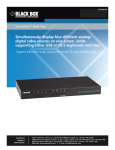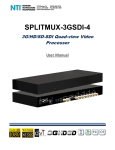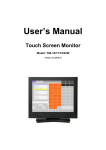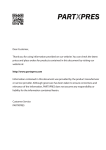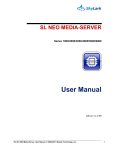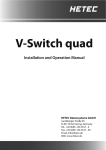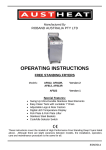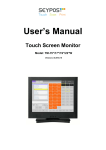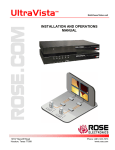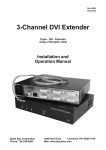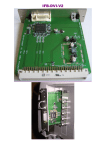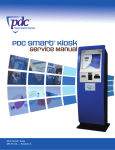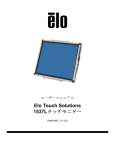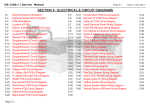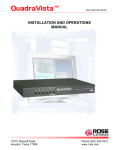Download SPLITMUX-DVI-4 - Network Technologies
Transcript
SPLITMUX® Series SPLITMUX-DVI-4 Quad Screen Video Splitter Installation and Operation Manual MAN093 Rev Date 12-1-11 TRADEMARK SPLITMUX is a registered trademark of Network Technologies Inc in the U.S. and other countries. COPYRIGHT Copyright © 2007, 2011 by Network Technologies Inc. All rights reserved. No part of this publication may be reproduced, stored in a retrieval system, or transmitted, in any form or by any means, electronic, mechanical, photocopying, recording, or otherwise, without the prior written consent of Network Technologies Inc, 1275 Danner Drive, Aurora, Ohio 44202. CHANGES The material in this guide is for information only and is subject to change without notice. Network Technologies Inc reserves the right to make changes in the product design without reservation and without notification to its users. FIRMWARE VERSION 3.02 WARRANTY INFORMATION The warranty period on this product (parts and labor) is two (2) years from the date of purchase. Please contact Network Technologies Inc at (800) 742-8324 (800-RGB-TECH) or (330) 562-7070 or visit our website at http://www.networktechinc.com for information regarding repairs and/or returns. A return authorization number is required for all repairs/returns. i SPLITMUX-DVI-4 3.02 Release Notes Correction for display of serial number in the OSD. SPLITMUX-DVI-4 3.00 Release Notes Transparent USB 2.0 Matrix The transparent USB 2.0 Matrix allows switching of up to four USB devices to the connected hosts. New improved Video ICs The new video processor of V-Switch quad II provides best image quality in Quad, PiP, Dual and Fullscreen mode. New interpolation filters guarantee brilliant image quality when scaling. New equalizers allow connecting sources and console at up to 20 meters distance. Improved Input Video Mode Support New DVI receivers support any resolution up to 1920x1200@60 Hz at digital inputs following the VESA or CEA standards. Support for 1920x1200 and 1920x1080 at 50 Hz and 60 Hz as analog input modes. 1920x1200 and 1920x1080 at 50 Hz and 60 Hz are now supported as analog input modes. Improved EDID Management Input EDIDs can now be programmed comfortably. The content of monitor EDIDS can be copied into the input EDIDs. ii SPLITMUX-DVI-4 - 2.1 Release Notes SPLITMUX firmware version 2.1 contains new and improved features, including smooth transitions, manual input video mode selection, and automatic hiding of notifications like “no signal” to prevent burn-in. New Features in 2.1 Fade through black An elegant visual effect for presentations: When switching channels or display modes, the previous image fades to black, and the next image is faded in smoothly. Fade through black can be enabled or disabled by the user, and has five speed settings. Screen protection Some servers switch off their video output after a period of inactivity. To prevent burn-in, notifications such as “no signal” are hidden after 10 seconds. Manual settings for input video mode To enable users to ensure they always have the current input video mode, SPLITMUX now supports manual settings for modes that are difficult to distinguish automatically. Improved video mode detection Automatic input and output mode detection have been improved. SPLITMUX-DVI-4- 1.40a Release Notes SPLITMUX Firmware version 1.40a features improved keyboard compatibility and includes minor features and bug fixes. New Features in 1.40a Improved keyboard compatibility Version 1.40a adds compatibility with programmable keyboards that can send custom key combinations. Now you can efficiently operate a single unit as well as multiple cascaded units with the press of a button. Raw EDID data Using the CONSOLE->EDID menu, it is now possible to view the raw EDID data of the connected monitor to facilitate troubleshooting. New resolution HDTV 720p (1280x720) is now accepted both as an analog signal as well as a digital signal. Previous firmware versions only support digital HDTV resolutions. More on Cascading By cascading the Splitmux-DVI-4, you can connect up to 16 computers, and show them simultaneously on a single display. Please see drawings at the end of this manual. They are for 8 computers on a single console (or computers with multiple outputs). NOTE: Instead of using a standard keyboard you can use a key pad (like X-key) and program any command behind a single key. This allows switching comfortably between display modes and active channels. LIMITATION: Please remember the issue with the lack of resolution of displays and the real time video issue. There will be no real time video in each of the small quadrants even if you would lower each computers resolution to 800x600 and rise the refresh rate to 180Hz.. The reason is that the outputs of the “slave” Splitmux-DVI-4unit will only support up to 80Hz. This means about 10-12 frames per second for each of the up to 16 quadrants. iii SPLITMUX-DVI-4- 1.40 Release Notes Touch Screen Support SPLITMUX version 1.40 adds touch screen support to allow the user to operate four computers with a touch screen. The initial release includes support for touch screens from the following manufacturers: • elo AccuTouch 2116 Controller Series includes monitor models 1215L, 1229L, 1515L, 1522L, 1528L Medical, 1529L, 1537L, 1715L, 1729L, 1739L, 1915L, 1928L, 1928L Medical, 1939L, 2020L • TSharc Octopus Controller widely used, including in touch screens manufactured by 3M, Microtouch, TrollTouch, The Bergquist Company Version 1.40b and higher: - 2701 Controller Series (IntelliTouch, SecureTouch) iv TABLE OF CONTENTS TABLE OF CONTENTS INTRODUCTION FEATURES TECHNICAL SPECIFICATIONS SAFETY GUIDELINES HARDWARE - FRONT PANEL - LED indicators - Push buttons - Additional button functions - REAR PANEL - Power / Reset / Monitor - DVI-I / RS 232 / USB 1 1 3 4 5 5 5 6 7 8 8 9 INSTALLATION Connecting unit to power Connecting console (monitor, keyboard, mouse, touchscreen, trackball) Connecting sources / computers Connecting USB devices Powering up the system 10 10 10 11 11 11 ON SCREEN DISPLAY OSD - OVERVIEW OSD - MAIN MENU WINDOW OSD - NAVIGATION OSD SYSTEM - HOTKEY - HOTMOUSE FUNCTION - QUAD MODE - OSD POSITION - OSD LANGUAGE - SECURITY - SECURITY LEVELS - TEST PATTERN - DISABLE CHANNEL - CONTROL - DCP control - Example of DCP control - DCP synchronize - Example of DCP synchronization - SECURITY LEVELS 12 12 13 13 14 15 16 17 17 18 21 22 23 24 24 25 26 OSD MODE 27 31 - PIP - START OSD CONFIGURATION - BACKUP - RECALL - FACTORY RESET 32 32 33 OSD CONSOLE 34 35 36 38 39 40 - VIDEO OUTPUT - LAYOUT / LANGUAGE - Touchscreen - Fade - MULTI MONITOR - EDID SPLITMUX-DVI-4 - Installation and Operation Manual I TABLE OF CONTENTS TABLE OF CONTENTS ON SCREEN DISPLAY (continued) OSD VIDEO - input status - DVI/VGA - BRIGHTNESS - CONTRAST - HORIZONTAL POSITION - VERTICAL POSITION - SCREEN WIDTH - PHASE - FORMAT 41 41 42 42 42 42 43 43 44 OSD COMPUTER - KEYBOARD - MOUSE - RESET PS/2 - CHANGE EDID/DDC 46 46 47 47 OSD USB device 1-4 - usb port status - switching mode - change name 50 51 52 OSD HELP - HOTKEY - ABOUT - CONTACT 53 53 53 hotmouse ACTIVATING HOTMOUSE CURSOR HOTMOUSE CURSOR IN FULLSCREEN MODE / QUAD MODE HOTMOUSE CURSOR IN PIP MODE HOTMOUSE MENu - ACTIVATING - OPERATING - MODE - QUAD - FULL - PIP 54 54 55 56 58 58 59 59 60 SERVICE Maintenance and Repair - Technical Support 62 62 ANNEX DECLARATION OF CONFORMITY FCC DECLARATION keyboard Commands DEVICE CONFIGURATION PROGRAM FIRMWARE UPDATE SERIAL CABLE Dcp-Xml Remote Control SUPPORTED TOUCH SCREEN CONTROLLER SUPPORTED VIDEO INPUT SUPPORTED VIDEO OUTPUT CASCADING DELIVERABLES 63 63 64 65 67 69 70 71 72 73 74 75 76 II SPLITMUX-DVI-4 - Installation and Operation Manual INTRODUCTION FEATURES Thank you for choosing SPLITMUX-DVI-4 from NTI. This product represents the latest state-of-the-art technology in keyboard-video-mouse (KVM) switching. The SPLITMUX-DVI-4‘s key advantage over conventional KVM switches is that it allows you to simultaneously display and administer 4 computers on a single console. It combines key features of a high-end KVM switch and a digital multiviewer scaling and converting videos at both inputs and output. DISPLAY MODES QUAD MODE u In this mode, the screen is split into four fields of equal size each displaying the entire screen contents of one source. t FULLSCREEN MODE In Fullscreen mode, one of the four sources is displayed in full screen size and maximum resolution. PiP MODE (Picture in Picture) u Using this feature, the full screen display of one of the four video sources is accompanied by one to three small images (thumbnails) of the other video sources which are displayed on the right hand side of the screen allowing simultaneous monitoring. All PiP display modes are described in chapter OSD – MODE – PIP (pages 27ff). t DUAL MODE In Dual mode the left halves of the fullscreen images from two video sources are displayed side by side at full size and at full vertical resolution. For a version of Dual mode with two images side by side at full size (entire screen content, not only left halves) see page 22. SPLITMUX-DVI-4 - Installation and Operation Manual 1 INTRODUCTION FEATURES DVI & VGA SPLITMUX-DVI-4 supports resolutions of up to 1920 x 1200 @ 60 Hz for both DVI and VGA. Any combination of VGA and DVI at all standard resolutions is possible at inputs and output. Analog video input is converted to digital. If an analog display is connected, SPLITMUX-DVI-4 converts the digital signal to analog at the output. Internally, SPLITMUX-DVI-4 processes video purely digital guaranteeing best digital image quality. USB & PS/2 for keyboard / mouse / touch screen / trackball Use either PS/2 or USB ports on the computer to connect keyboard and mouse to SPLITMUX-DVI-4. It supports any combination. To connect the console, SPLITMUX-DVI-4 features two USB ports for mouse, keyboard, touchscreen or trackball connection. Transparent USB 2.0 SPLITMUX-DVI-4 features a transparent high speed USB 2.0 matrix: USB 2.0 devices (e.g. printer, external memory, memory stick,webcam, 3D mouse, finger printer) can be switched to computers connected. Operation There are six ways to operate SPLITMUX-DVI-4, switch channels, and select display modes: 1. Using the buttons on the front of the unit 2. Using configurable hotkeys 3. Using the unit’s external configuration program on a remote computer 4. Via a serial port using the protocol DCP XML 5. Using mouse functions (Hotmouse) 6. Using a touch screen The configuration of SPLITMUX-DVI-4 is effected via an On Screen Display (OSD) opened and and navigated either with keyboard commands or front panel buttons or remotely via ConfDev on an external PC. The LEDs on the front panel indicate the unit’s current status. Use the serial (RS232) port for remote control and firmware updates. 2 SPLITMUX-DVI-4 - Installation and Operation Manual INTRODUCTION TECHNICAL SPECIFICATIONS Casing: Desktop or 19“, black (RAL 9005) Dimensions WxDxH: 43.6 x 23.4 x 4.4 cm Weight: 2.9 kg Operating controls: Front panel: Four channel selection buttons, one Quad mode button, one PiP mode button, one Fullscreen mode button Rear panel: One Power On/Off switch, one Reset button Indicators: Four active channel indicator LEDs, one Quad mode LED, one PiP mode LED, one Fullscreen mode LED Computer ports: 4 x DVI-I (analog and digital), 4 x PS/2, 4 x USB Console ports: 1 x DVI-I, 2 x USB for keyboard and mouse Transparent USB 2.0 ports:4 x transparent high-speed USB 2.0 Maximum distance: Video (DVI / VGA) up to 20 meters; keyboard / mouse up to 5 meters Input and output resolution: up to 1920 x 1200 @ 60 (DVI and VGA) * EDID adjustments: EDID at each input port customizable Supported keyboard layouts: German, English, French, Italian, Spanish, Japanese Power supply: Internal AC adapter, 100 to 240V 50/60 Hz Power consumption: 40 watts Operating temperature: 5 to 45°C Storage temperature: -10 to 60 °C Rel. humidity: 5 to 65% non-condensing *(at WUXGA: reduced blanking only - WUXGAr) SPLITMUX-DVI-4 - Installation and Operation Manual 3 INTRODUCTION SAFETY GUIDELINES WARNING: To avoid risk of electric shock do not open the device or remove any part of the casing. Please contact our technical support if the device requires servicing. Please read this manual carefully before putting the device into operation. Observe all warnings and instructions on the device and in the operation manual. Keep this user manual for future reference. Power supply: Only connect the device to a grounded power supply. Installation: Ensure that the device is disconnected from the mains before performing any installation work. Unplug the device or disconnect the power supply. Cables: Only use the cables supplied by NTI together with the device. Damage resulting from the use of third-party cables is not covered by warranty. Take care not to create tripping hazards when laying cables. Location: Electronic devices should never be placed on the ground between the cables. Never obstruct any vents the device may have. Take care to ensure adequate ventilation. Maintenance: This device is maintenance-free. Never open the casing. No settings can be made inside the device. 4 SPLITMUX-DVI-4 - Installation and Operation Manual INTRODUCTION HARDWARE FRONT PANEL The SPLITMUX-DVI-4 front panel has seven status indicators (LEDs) and seven buttons. Buttons 1 to 4 switch between channels, LEDs 1 to 4 indicate the status of the individual channels. Full, Quad and PiP buttons and LEDs are used to switch and indicate display modes and other functions, e.g. open the OSD menu etc. Status LEDs Front panel Buttons Indicators - LEDs 1 to 4: When these LEDs light up green, the corresponding channel (computer port) has been selected and is available for keyboard and mouse access. When a LED flashes green, there is no signal at the video input of the selected channel. An LED lights up yellow when there is a signal at the video input, but another channel has been selected. When the LED is dark, there is no signal at the video input and another channel has been selected. - LED Full: This LED lights up green when the Fullscreen mode is selected. - LED Quad: When this LED lights up green, the unit is in Quad mode. - LED PiP: This LED lights up green when the PiP function is enabled. Note: While the OSD menu is open, the active computer can still be operated by mouse. SPLITMUX-DVI-4 - Installation and Operation Manual 5 INTRODUCTION HARDWARE FRONT PANEL (continued) Push buttons - Buttons 1 to 4: These buttons activate the corresponding channel (computer port). - Full button: Press to chose the Fullscreen mode. - Quad button: Press this button to switch from Fullscreen mode to Quad mode. - PiP button: Press this button to enable the PiP (picture in picture) function. Selector You can also select the active channel using hotkey and the arrow keys. The selection window closes upon expiry of the channel selection timeout period. Channel selection timeout is configured in OSD under SYSTEM u QUAD MODE. Use the “Time out of channel selection:” menu item to define how long the selector is to be displayed. 6 SPLITMUX-DVI-4 - Installation and Operation Manual INTRODUCTION HARDWARE FRONT PANEL (continued) Additional button functions Setting output resolution to safe display modes To set output resolution to 640 x 480 pixel @ 60 Hz simultaneously press buttons 1 and 2 for longer than 1 second. Use of this feature is recommended when you cannot use the OSD (on screen display dark or illegible) because the output resolution setting is not supported by the monitor. After setting the correct output resolution (640x480@60), you can choose a resolution the connected monitor supports in the OSD. Alternatively, hold buttons 1 and 2 again to cycle through the following video modes: VGA 640x480@60, SVGA 800x600@60, XGA 1024x768@60, UXGA 1600x1200@60, and the preferred video resolution found in the monitor EDID. LEDs 1 to 4 and FULL indicate the selected mode. Resolution VGA, SVGA, XGA and UXGA Hardware Reset Press buttons 3 and 4 simultaneously for longer than 4 seconds in order to reset the unit completely (video + mouse + keyboard) (see also page 8: Reset button) Note: Due to the “keep alive” function of keyboard and mouse, turning power off/on resets only the video circuit. Hardware Reset Calling up OSD Simultaneously press Quad and PiP buttons for longer than one second to open the OSD menu. Note: While the OSD menu is open, the active computer can still be operated by mouse. OSD Menu SPLITMUX-DVI-4 - Installation and Operation Manual 7 INTRODUCTION HARDWARE REAR PANEL The rear panel of SPLITMUX-DVI-4 features four input source/computer ports, the console port (KVM), the serial RS232 port, four transparent high-speed USB 2.0 device ports, the power connection, and a reset button. 1 2 3 4 5 6 1 - Power 2 - Reset 3 - Monitor / DVI-I output 4 - Four DVI-I inputs 5 - RS232 / RJ45 port 6 - USB for keyboard, mouse, touch or trackball (console) 7 - USB or PS2 keyboard and mouse (computer) 8 - Four transparent high-speed USB 2.0 ports 7 8 1 - Power Plug for enclosed power cable. 2 - Reset Press this button, using a suitable pointed object (e.g. ballpoint pen), for an entire reset of SPLITMUX-DVI-4. Note: Due to the “keep alive” function of keyboard and mouse, turning power off/on resets only the video circuit. If you experience problems with mouse or keyboard, we therefore recommend executing a complete RESET by either pressing the RESET button on the rear panel or by simultaneously pressing buttons 3 and 4 on the front panel for longer than 4 seconds (see page 7 – Hardware Reset). 3 - Monitor / DVI-I output Connect your analog or digital display to this DVI-I port. 8 SPLITMUX-DVI-4 - Installation and Operation Manual INTRODUCTION HARDWARE REAR PANEL (continued) 4 - DVI-I inputs Connect the analog or digital video signal of your up to four sources to these four DVI-I ports. 5. - RS 232 / RJ45 port Connect external serial control devices to this RJ-45 port to operate SPLITMUX-DVI-4 remotely, e.g. connect to this port to access the OSD menu from a computer using the ConfDev device configuration tool (see page 67). The serial RS 232 port is also used for firmware updates (see page 69). 6 - USB for keyboard, mouse, touch or trackball (console) Two USB ports allow connecting keyboard, mouse, touch screen or trackball. Using a USB-Hub, you can connect multiple keyboards and mice. They will work in share mode with an inactivity timeout of 3 seconds. 7 - USB or PS2 keyboard and mouse (computer) Each computer source can be connected with PS/2 or USB-B for keyboard and mouse. 8 - Four transparent high-speed USB 2.0 ports USB devices (printer, memory stick, finger printer, 3D mouse) are connected to the four transparent USB ports. This transparent USB 2.0 matrix switches USB 2.0 periphals to computer sources connected to SPLITMUXDVI-4. SPLITMUX-DVI-4 - Installation and Operation Manual 9 INSTALLATION INSTALLATION SPLITMUX-DVI-4 is best located as close as possible to the sources / computers to reduce the length of cables. By default, SPLITMUX-DVI-4 is delivered as desktop version. Using the rack mount kit supplied, it may also be mounted in a 19” rack. See deliverables page 76. Keyboard, monitor, mouse (console) and USB devices are connected to SPLITMUX-DVI-4 by means of the corresponding cables (DVI, USB or PS/2). KVM extenders allow you to work remotely via CAT5, fiber optic or Ethernet connection. Connecting unit to power - Plug the power cable into the power plug located on the rear panel of SPLITMUX-DVI-4, but do not turn power on yet. Connecting console (monitor, keyboard, mouse, touch screen, trackball) - Connect your monitor to the monitor port of SPLITMUX-DVI-4 via VGA-DVI cable (analog) or DVI cable (digital) up to 20 meters. For greater distances use a DVI or VGA extender. - Connect your USB mouse and keyboard to the USB-A ports on the console up to 5 meters. For greater distances use a KVM or USB extender. - PS/2 mouse and keyboard can be connected to SPLITMUX-DVI-4 using a PS/2-USB adaptor. - Connect your touchscreen to the DVI-I port and the USB-A port (for calibration see page 36) DVI-I USB-A KVM console with digital or analog monitor, USB mouse and USB keyboard Note: Maximum cable length for video (DVI / VGA) is up to 20 meters. Maximum cable length for USB / PS2 keyboard and mouse is up to 5 meters. For greater distances SPLITMUX-DVI-4 supports most KVM extenders, video (DVI / VGA) extenders, and USB extenders. 10 SPLITMUX-DVI-4 - Installation and Operation Manual INSTALLATION INSTALLATION Connecting sources / computers - Switch off the computer and disconnect keyboard, monitor and mouse. - Connect keyboard and mouse to the computer ports either with a single USB cable or via the PS/2 interface (use the Y cable) up to 5 meters. For greater distances use a KVM or USB extender. - To connect an analog video / computer source (VGA) to SPLITMUX-DVI-4, use a VGA-DVI cable. Digital video sources are connected via a DVI cable up to 20 meters. For greater distances use a DVI or VGA extender. Connecting USB devices Connect your USB device to one of the four transparent USB ports to use it with computers connected to SPLITMUX-DVI-4. It supports transparent USB devices such as printer, external memory, 3D mouse, and finger printer. (Configuration see page 50) Connect USB-Devices e.g. Printer, USB-Stick, ... Powering up the system - Switch on SPLITMUX-DVI-4 with the power switch on the rear panel. All front panel LEDs light up briefly indicating that SPLITMUX-DVI-4 is ready for operation. SPLITMUX-DVI-4 is now in Quad mode (default). - Power up all connected computers. SPLITMUX-DVI-4 recognizes all input video sources automatically and displays them on your monitor screen. - To select another display mode, use the relevant keyboard commands (see page 65) or buttons on the front panel (page 6). SPLITMUX-DVI-4 - Installation and Operation Manual 11 ON SCREEN DISPLAY OSD - OVERVIEW SYSTEM HOTKEY HOTMOUSE QUAD MODE OSD POSITION OSD LANGUAGE SECURITY TEST PATTERN DISABLE CHANNEL CONTROL Multiple Hotkey / Double Click Hotkey Hotmouse Recognition, Hotmouse Timeout Channel Selection Timeout Position of OSD window German / English / Spanish Set security level Crosshairs – Color gradient - Rhombus - Rectangle – Stripes Deactivate unused channels Device control via DCP-XML protocol (RS232) MODE PIP (picture in picture) START Size, zoom, position and display modes Set start configuration CONFIGURATION BACKUP RECALL FACTORY RESET Save configuration settings Restore last saved configuration Reset to factory default settings CONSOLE VIDEO OUTPUT Video resolution and frequency KEYBOARD Keyboard layout TOUCHSCREEN Calibration / Mouse key emulation / Enlarge on touch FADE Smooth transitions MULTI MONITOR Assign mouse/keyboard to video EDID Read and display EDID data of monitor VIDEO INPUT STATUS DVI / VGA BRIGHTNESS CONTRAST HORIZ POSITION VERT POSITION SCREEN WIDTH PHASE FORMAT Display computers’ video input resolutions Setting: DVI - VGA – VGA/DVI – DVI/VGA Set brightness of analog input signal Set contrast of analog input signal Horizontal screen position Vertical screen position Set screen width of analog input signal Adjust phase of analog input signal Fit input format to screen COMPUTER KEYBOARD MOUSE RESET PS/2 EDID / DDC Display type of keyboard (PC1, PC2, PC3 or USB) Display type of mouse (PS/2, PS/2 Wheel or USB) Set USB mouse positioning (absolute / relative) Reset PS/2 mouse and keyboard Program input EDID USB DEVICE 1-4 USB PORT STATUS CHANGE Shows USB 2.0 matrix status Switch to / Switching mode / Device name HELP HOTKEY INFO CONTACT List of keyboard commands Revision level – firmware / hardware Contact information 12 SPLITMUX-DVI-4 - Installation and Operation Manual ON SCREEN DISPLAY OSD - MAIN MENU WINDOW There are three ways to open the OSD main menu (figure): - use keyboard command „hotkey“ + „O“ (see Annex pages 65f) - simultaneously press front panel buttons „Quad“ + „PiP“ for longer than one second - remotely open the OSD via ConfDev program on an external PC with serial connection (see Annex pages 67f) The main menu pops up in the center of the screen (on top of the video image). OSD Start Main Menu OSD - NAVIGATION Using the On Screen Display is simple and easy. To navigate either use the buttons on the front panel or your keyboard. Navigation with keyboard To navigate from one field to the next in the OSD menu use the UP and DOWN arrow keys or TAB/SHIFT-TAB keys. Use the LEFT and RIGHT arrow or + (PLUS) and – (MINUS) keys to change the value in the current field. Press ENTER to select a menu item. Press ESC to return to the previous window (higher menu level) or exit the OSD. Changes in parameters are saved automatically. Navigation using the buttons on the front panel Corresponding keys on console keyboard Navigation using the buttons on the front panel is analogous to using the console keyboard. Buttons 1 and 2 correspond to the UP and DOWN arrow keys and buttons 3 and 4 to the LEFT and RIGHT arrow keys or +/keys. Confirm your entry by pressing the PiP / select button. Press the Quad / exit button to return to the previous page (higher menu level) or exit the OSD. Changed settings are saved automatically. Note: Keyboard commands are possible while the OSD window is open. To activate hotkey commands, use the CTRL key instead of the currently set hotkey (page 65f). SPLITMUX-DVI-4 - Installation and Operation Manual 13 ON SCREEN DISPLAY OSD - SYSTEM - HOTKEY HOTKEY Use the arrow keys to navigate in the SYSTEM menu to the entry HOTKEY and press the ENTER/SELECT key to open the HOTKEY window. Two different hotkey modes are available: - For multiple hotkey commands you can define one to four keys which are pressed simultaneously to enter the command mode. Selectable keys are: STRG, SHIFT, ALT and WINDOWS. - For double click hotkey commands you can choose one key, which is double clicked to enter the command mode. Selectable keys are: STRG, SHIFT, ALT and SCROLL. To change the hotkey mode or select another hotkey, navigate with the TAB or ARROW UP/DOWN keys to the respective field and use the ARROW LEFT/RIGHT or the +/- keys to change the setting. Multiple Hotkeys The command mode is indicated by LED flashing on the console keyboard. Default setting: Multiple Hotkey: CTRL + ALT Note: For a list of hotkeys to operate SPLITMUX-DVI-4 see Annex page 65f. 14 SPLITMUX-DVI-4 - Installation and Operation Manual Double Click Hotkeys ON SCREEN DISPLAY OSD - SYSTEM - HOTMOUSE HOTMOUSE FUNCTION Use the arrow keys to navigate in the SYSTEM menu to the entry HOTMOUSE and press ENTER/SELECT to open the HOTMOUSE window. Hotmouse is an exclusive function that comes with NTI SPLITMUX-DVI-4. It works with your standard mouse or trackball. To activate Hotmouse operation, navigate to “Enable Hotmouse” and change the setting to “Yes”. There are two modes of Hotmouse operation: Hotmouse Cursor and Hotmouse Menu. While Hotmouse Cursor supports only a limited set of operations, Hotmouse Menu allows execution of all switch operations and PiP settings. While the Hotmouse function is activated, the active computer can still be operated by keyboard. For a detailed description of Hotmouse, Hotmouse functionalities, and Hotmouse menu please see chapter HOTMOUSE on pages 54ff. SPLITMUX-DVI-4 - Installation and Operation Manual 15 ON SCREEN DISPLAY OSD - SYSTEM - QUAD MODE QUAD MODE Use arrow keys to navigate in the SYSTEM menu to the entry QUAD MODE and press ENTER/SELECT to open the QUAD MODE window. Channel selection timeout defines the period (1 to 30 seconds) after which the selector will close automatically. Default setting is 5 seconds. Selector In Quad mode, use hotkey ‘Q’ to open the selector. The selector indicates the active channel (mouse and keyboard enabled). Alternatively, press front button „Quad”. Press hotkey + arrow key to switch the selector (active channel) from one channel to the next. After expiry of the selector timeout, the selector closes. 16 SPLITMUX-DVI-4 - Installation and Operation Manual ON SCREEN DISPLAY OSD - SYSTEM - OSD POSITION / OSD LANGUAGE OSD POSITION Use arrow keys to navigate in the SYSTEM menu to the entry OSD POSITION and press ENTER/SELECT to open the OSD POSITION window. Use this function to move the OSD window to any position on the screen. OSD LANGUAGE Use arrow keys to navigate in the SYSTEM menu to the entry OSD LANGUAGE and press ENTER/SELECT to open the OSD LANGUAGE window. Set OSD LANGUAGE to either Deutsch (German), Español (Spanish), or English (default: English). SPLITMUX-DVI-4 - Installation and Operation Manual 17 ON SCREEN DISPLAY OSD - SYSTEM - SECURITY SECURITY – SECURITY LEVELS Use arrow keys to navigate in the SYSTEM menu to the entry SECURITY and press ENTER/SELECT to open the SECURITY window. The SECURITY feature allows you to reduce the functional range of SPLITMUX-DVI-4. Eight security levels are available for this purpose. By default, all functions are enabled (security level 0). To change the security level, you must first enter a predefined password. This six-digit password is enclosed separately with the deliverables of SPLITMUX-DVI-4 and should only be accessible to authorized persons (administrators etc.). After entering the password on the keyboard or front panel (password is not displayed in password field), the SECURITY window opens. Enter the desired security level (0 to 8) under “Select security level”. SECURITY LEVEL 0 This is the default setting of SPLITMUX-DVI-4. All settings are allowed and all functions are enabled. 18 SPLITMUX-DVI-4 - Installation and Operation Manual ON SCREEN DISPLAY OSD - SYSTEM - SECURITY Note: Before changing the security level, please set the configuration you wish to work with to the higher security level, under MODE u START (see page 31). This configuration will be maintained when SPLITMUX-DVI-4 is reset, in case of power failure, or when power is turned off and on again. SECURITY LEVEL 8 Security level 8 allows you to work only on one channel (computer) in a predefined display mode (Quad, Fullscreen or PiP mode). No settings can be changed, apart from the SECURITY menu item, where you can change the security level. SYSTEM SECURITY SECURITY LEVEL 7 As security level 8, but you can open OSD windows that only show display modes and device settings. CONSOLE VIDEO OUTPUT/EDID VIDEO INPUT STATUS COMPUTERKEYBOARD/MOUSE/EDID/DDC HELP HOTKEY/ABOUT/CONTACT SECURITY LEVEL 6 As security level 7, with the following additional operations: SYSTEM CONTROL CONSOLE FADE - Setting of active channel using front panel buttons, hotkeys or hotmouse - Selecting channel with PiP button in Quad mode - Changing the directly selectable PiP channel in PiP mode single direct SECURITY LEVEL 5 As security level 6, with the following additional operations: - Setting of display mode (Quad / Fullscreen / PiP) using front panel buttons, hotkeys or hotmouse. SYSTEM TEST PATTERN SPLITMUX-DVI-4 - Installation and Operation Manual 19 ON SCREEN DISPLAY OSD - SYSTEM - SECURITY SECURITY LEVEL 4 As security level 5, with the following additional settings in the OSD: SYSTEM OSD POSITION MODE PIP / START CONFIGURATION RECALL VIDEO FORMAT - Modify PiP settings in Hotmouse menu - Changing both channels in Dual mode - Changing the fixed PiP channel in PiP mode single fixed SECURITY LEVEL 3 As security level 4, with the following additional settings in the OSD: SYSTEM VIDEO USB DEVICE 1-4 OSD LANGUAGE BRIGHTNESS / CONTRAST / HORIZ POSITION / VERT POSITION SCREEN WIDTH / PHASE SECURITY LEVEL 2 As security level 3, with the following additional settings in the OSD: SYSTEM HOTKEY / HOTMOUSE / QUAD MODE CONSOLEKEYBOARD / TOUCHSCREEN SECURITY LEVEL 1 As security level 2, with the following additional settings in the OSD: SYSTEM CONSOLE VIDEO COMPUTER DISABLE CHANNEL MULTIMONITOR / VIDEO OUTPUT DVI/VGA MOUSE / RESET PS/2 - Switch video output to VGA (using hotkey ‘V’ or front panel buttons 1+2) 20 SPLITMUX-DVI-4 - Installation and Operation Manual ON SCREEN DISPLAY OSD - SYSTEM - TEST PATTERN TEST PATTERN Use arrow keys to navigate in the SYSTEM menu to the entry TEST PATTERN and press ENTER/SELECT to open the TEST PATTERN window. Use the Test Pattern feature to check monitor quality (pixel errors, contrast, etc) or the functionality of the SPLITMUX-DVI-4’s video output. It is recommended to use all available test patterns for the test procedure. To exit TEST PATTERN mode, use the front panel buttons „Quad” „Full” or „PiP” or hotkey commands accordingly. SPLITMUX-DVI-4 - Installation and Operation Manual 21 ON SCREEN DISPLAY OSD - SYSTEM - DISABLE CHANNEL DISABLE CHANNEL Use arrow keys to navigate in the SYSTEM menu to the entry DISABLE CHANNEL and press ENTER/SELECT to open the DISABLE CHANNEL window. If two or three computers or video sources are connected to SPLITMUX-DVI-4, use the DISABLE CHANNEL feature to ensure that for the unused channels: a) message "no signal input x" is not shown in Quad mode b) PiP images are not displayed on screen c) these channels are not selectable in Fullscreen mode For example, if you have connected three computers (channel 1 to 3) to SPLITMUX-DVI-4, use the arrow keys to navigate to the number 3 and confirm by pressing ENTER/SELECT. Note: To use the “DISABLE CHANNEL” feature, computers/video sources must be connected to SPLITMUX-DVI-4 in ascending order from channel 1 to 4. Example in Quad mode: All four channels enabled Three channels enabled 22 Two channels enabled mid-height SPLITMUX-DVI-4 - Installation and Operation Manual ON SCREEN DISPLAY OSD - SYSTEM - CONTROL CONTROL Use arrow keys to navigate in the SYSTEM menu to the entry CONTROL and press ENTER/SELECT to open the CONTROL window. NTI devices can be controlled via DCP (Device Control Protocol), an XML-based protocol. (see page 71 in Annex) There are two DCP modes: DCP control, which allows external control of the display mode. DCP synchronize, which keeps several SPLITMUX-DVI-4 devices in the same display mode. Default setting is “off”, which prevents any external CONTROL. Use a serial cable to connect a control unit to the RS 232 port (RJ 45) on the SPLITMUX-DVI-4 rear panel. To synchronize several devices, special Y cables are required. Settings for the connection are: Transfer rate 57600 baud, 8 data bits, no parity, 1 stop bit, no flow control The two control modes operate as follows: DCP control This mode allows direct control of a single switch by means of a control device, e.g. a computer. The control device can query and change the mode of SPLITMUX-DVI-4. SPLITMUX-DVI-4 responds to each DCP message sent by the control device with a DCP reply. This reply includes the values of all settings queried or set by means of the last message. If the message sent by the control unit contains errors, the switch will reply by sending an error message. SPLITMUX-DVI-4 - Installation and Operation Manual 23 ON SCREEN DISPLAY OSD - SYSTEM - CONTROL Example of DCP control A SPLITMUX-DVI-4 is controlled via DCP-XML by a computer connected by serial cable. For an introduction to the DEVICE CONTROL PROTOCOL please see page 71 in Annex. DCP synchronize Use this mode to keep several SPLITMUX-DVI-4 devices in the same mode. Every change in settings initiated in the first switch by Hotkeys, Hotmouse, Front panel buttons, or a controlling device synchronizes the modes of all connected devices via DCP messages. Special serial Y cables are used for this purpose (see example on page 70) Important: Each time you restart a SPLITMUX-DVI-4 set to synchronize, it will send all its settings to the next connected device. This process also takes place after activating synchronize in the OSD menu. When starting a chain of devices, always start by first switching on the device at the end of the chain. When the device has completed its startup phase and sent its DCP messages, switch on the next device in the chain. Finally, switch on the first device in the chain, which synchronizes the settings of all other devices in the chain with its own settings as it starts up. 24 SPLITMUX-DVI-4 - Installation and Operation Manual ON SCREEN DISPLAY OSD - SYSTEM - CONTROL Example of DCP synchronization SPLITMUX-DVI-4 2 and 3 are synchronized with SPLITMUX-DVI-4 1. SPLITMUX-DVI-4 1 SPLITMUX-DVI-4 2 SPLITMUX-DVI-4 3 To synchronize, SPLITMUX-DVI-4 1 sends every change in settings as a DCP message via the serial Y cable to the RX input of SPLITMUX-DVI-4 2. SPLITMUX-DVI-4 2 adopts the settings and sends a DCP message via TX output over the Y cable to the RX input of SPLITMUX-DVI-4 3. The synchronization chain can have any length. Do not connect the last device in the chain to the first device (i.e. do not create a loop). SPLITMUX-DVI-4 - Installation and Operation Manual 25 ON SCREEN DISPLAY OSD - SYSTEM - CONTROL SECURITY LEVELS The security level settings in the OSD menu described on page 18ff also apply to control via DCP messages. Queries are possible up to security level 7. The table below shows the maximum security levels for simple element settings. These settings may be changed via DCP up to the specified protection level. Maximum security level for: Console Channel 6 Video Channel 6 Video Layout 5 PiP Layout 4 PiP Size 4 PiP Offset 4 PiP Zoom 4 PiP Channel 4 DUAL ChannelS (L/R) 6 PiP Scan Time 4 26 SPLITMUX-DVI-4 - Installation and Operation Manual ON SCREEN DISPLAY OSD - MODE - PIP PiP (Picture in Picture Function) Use arrow keys to navigate in the MODE menu to the entry PIP and press ENTER/SELECT to open the PIP window. In the PIP window you can configure PiP size, position, and display mode. PiP size Adjust the size of PiP images to your requirements. 12 (single mode) or 9 (triple mode) different sizes are available: Single: 3 % - 5 % - 7 % - 10 % - 15 % - 20 % - 25 % - 28 % - 33 % - 38 % - 44 % - 50 % Triple: 3 % - 5 % - 7 % - 10 % - 15 % - 20 % - 25 % - 28 % - 33 % 50 % equals the size of one quad screen (one quarter of a full size screen). PIP zoom factor Use this option to zoom the center of the PiP images by a factor of 2. Offset from top Use this option to change the position of PiP images. PiP images can be moved vertically to any position on the screen’s right hand margin. Note: All settings also possible via Hotmouse menu, see page 54. SPLITMUX-DVI-4 - Installation and Operation Manual 27 ON SCREEN DISPLAY OSD - MODE - PIP PIP Display Modes SPLITMUX-DVI-4 offers the following PiP modes: PIP display mode triple: All other video sources are displayed (three PiP images) Triple gap: PiP images are displayed with a gap in place of the active channel. Triple no gap: PiP images are displayed without a gap. Triple tile: The size of the main image and the PiP images is optimized so that the main image and the PiP images are shown as large as possible without overlapping. 28 SPLITMUX-DVI-4 - Installation and Operation Manual ON SCREEN DISPLAY OSD - MODE - PIP PIP Display Modes (continued) PIP display mode single: One PiP image is displayed. You can choose between different display modes: Single fixed: One channel is selected to be displayed as permanent PiP image. Only the active channel (full image) can be switched. Press front panel buttons 1, 2, 3, or 4 to switch the full image. Single direct: One channel is selected to be displayed as permanent full image (active channel). Only the PiP can be switched. Press front panel buttons 1, 2, 3, or 4 to switch the full image. SPLITMUX-DVI-4 - Installation and Operation Manual 29 ON SCREEN DISPLAY OSD - MODE - PIP PIP Display Modes (continued) Single dual: In Dual mode the left halves of the fullscreen images from two video sources are displayed side by side. You can choose the left or the right image as the active channel. To switch the active channel use the OSD, hotkeys or front buttons. Single scan: Within a PiP image, the three other video sources are displayed one after the other; the delay can be set to between one and nine seconds. 30 SPLITMUX-DVI-4 - Installation and Operation Manual ON SCREEN DISPLAY OSD - MODE - START START (Set start mode) Use arrow keys to navigate in the MODE menu to the entry START and press ENTER/SELECT to open the START window. This feature allows you to define the start configuration, i.e. the display mode (Quad, Fullscreen, or PiP), active channel, and PiP settings which SPLITMUX-DVI-4 uses after a reset or when the system is powered up. When the START menu is called up, the current start configuration is displayed. To modify your start configuration, change parameters in the channel, mode, and PiP fields. Press ESC to save the new parameters and exit the START menu. Choose “Use current mode” to adopt the current settings as start mode. Use arrow keys to navigate to “Use current mode” and confirm by pressing ENTER. The factory default start mode is Quad-mode with active channel 1. Default start screen Example of a start screen configuration SPLITMUX-DVI-4 - Installation and Operation Manual 31 ON SCREEN DISPLAY OSD - CONFIGURATION - BACKUP / RECALL BACKUP Use arrow keys to navigate in the CONFIGURATION menu to the entry BACKUP and press ENTER/SELECT to open the BACKUP window. This function saves the current device settings, including the start mode set in MODE START. Note: The EDID configuration will not be saved and can not be recoverd with the RECALL function. OSD - CONFIGURATION - RECALL RECALL Use arrow keys to navigate in the CONFIGURATION menu to the entry RECALL and press ENTER/SELECT to open the RECALL window. Use this feature to replace the current settings with the last configuration saved using the BACKUP command. 32 SPLITMUX-DVI-4 - Installation and Operation Manual ON SCREEN DISPLAY OSD - CONFIGURATION - FACTORY RESET FACTORY RESET Use arrow keys to navigate in the CONFIGURATION menu to the Factory Reset and press ENTER/SELECT to open the DEFAULTS window. Use this function to reset the current settings of SPLITMUX-DVI-4 to the factory default configuration. All four input EDIDs are also reseted to their default values. If necessary, save your current settings before using the DEFAULTS command. Execution of this command results in a complete reset and reboot of SPLITMUX-DVI-4 with factory defaults. FACTORY DEFAULTS: SYSTEM HOTKEY HOTMOUSE QUAD MODE OSD POSITION OSD LANGUAGE SECURITY DISABLE CHANNEL CONTROL = Multiple Hotkey / Hotkey = Ctrl + Alt = ON / Hotmouse timeout = 5 sec. = Channel selection timeout = 5 sec. = centered = English = None (security level = 0) = All four channels are active = Off MODE PIP = Size = 15 % Zoom factor = 1 Display mode = triple Active channel = gap; Offset from top = 0 % Start configuration = Quad / active channel = 1 CONSOLE VIDEO OUTPUT = auto KEYBOARD = English TOUCHSCREEN = Mouse emulate right click / Quad remains / PiP switches FADE = Off MULTI MONITOR = Monitor 1 --> Channel 1; Monitor 2 --> Channel2; Monitor 3 --> Channel 3; Monitor 4 --> Channel4; VIDEO VIDEO INPUT BRIGHTNESS CONTRAST HORIZ POSITION VERT POSITION SCREEN WIDTH PHASE FORMAT COMPUTER MOUSE USB mouse positioning = relative (all channels) EDID / DDC 1600x1200@60, 1920x1200@60, digital USB DEVICE 1-4 = DVI / VGA (all channels) = +0 (all channels) = 56 % (all channels) = auto (all channels) = auto (all channels) = +0 (screen-width correction of all channels) = +0 (all channels) Fit to screen = No (all channels) = Off / manual switching w. warning / name: Device 1 (-4) SPLITMUX-DVI-4 - Installation and Operation Manual 33 ON SCREEN DISPLAY OSD - CONSOLE - VIDEO OUTPUT VIDEO OUTPUT Use arrow keys to navigate in the CONSOLE menu to the entry VIDEO OUTPUT and press ENTER/SELECT to open the VIDEO OUTPUT window. Change with ENTER/SELECT Use the VIDEO OUTPUT menu to choose an output resolution supported by your monitor. Press ENTER/SELECT to enter the selection menu. Use arrow keys to select the desired line in the list shown on the right and press ENTER/SELECT for the new video format. When the output mode is set to ‘auto’, SPLITMUX-DVI-4 chooses a resolution by reading the connected monitor’s EDID data. Choose the EDID menu item to check whether the connected monitor provides this data. If the monitor does not offer this data, SPLITMUX-DVI-4 sets VGA mode (640x480@60Hz) as default and activates Sync on Green. Sync on Green can be deactivated on SPLITMUX-DVI-4. The new output mode is visible for 10 seconds. Within this time you can either accept the new setting by pressing ENTER/SELECT or return to your original setting by pressing ESC/EXIT. 34 SPLITMUX-DVI-4 - Installation and Operation Manual ON SCREEN DISPLAY OSD - CONSOLE - LANGUAGE / LAYOUT LANGUAGE / LAYOUT Use arrow keys to navigate in the CONSOLE menu to the entry KEYBOARD and press ENTER/SELECT to open the KEYBOARD window. Set the keyboard layout to the desired language, English, Deutsch (German), Español (Spanish), Français (French), Italiano (Italian) or Japanese. SPLITMUX-DVI-4 - Installation and Operation Manual 35 ON SCREEN DISPLAY OSD - CONSOLE - TOUCHSCREEN TOUCHSCREEN SPLITMUX-DVI-4 enables the user to use a touchscreen to control and switch between four computers as well as change display modes. SPLITMUX-DVI-4 supports a great number of USB touch screens with commonly integrated touch controllers. For a list of supported touchscreens, please see Annex on page 72. To control SPLITMUX-DVI-4 using a touchscreen, connect the touchscreen to SPLITMUX-DVI-4 by connecting the VGA or DVI cable from the SPLITMUX-DVI-4 monitor port to the input of the touchscreen. Connect the USB port of the touchscreen to the SPLITMUX-DVI-4 console USB port. Please see page 8ff for a description of the SPLITMUX-DVI-4 ports. Calibration After connecting a touchscreen to SPLITMUX-DVI-4 for the first time, calibrate the touchscreen. Open CONSOLE u TOUCHSCREEN menu, choose CALIBRATE, and press ENTER/SELECT. Four markers will be displayed in the corners of the touchscreen. The diagram shows the first marker in the top left corner of the screen. Touching the center of the markers as accurately as possible yields best calibration results. Then repeat for the other three markers to complete calibration. Mouse key emulation SPLITMUX-DVI-4 offers three modes of interpreting the user input as mouse clicks. 1. Mouse: When touching the touchscreen, the mouse button is pressed. When the finger is released from the touchscreen, the mouse button is released. This mode can be used for drag and drop operations. 2. Click on touch: When touching the touchscreen, a mouse click is generated at the position of the touch. 3. Click on release: When the finger is released from the touchscreen, a mouse click is generated at the last position of the finger. By default, „mouse” is set as mode. You could use your finger on the touchscreen similarly to using your mouse. “Click on touch” and “click on release” are suited for kiosk applications or environments where touchscreens are used instead of keyboards and mice, such as in medical industries for hygienic reasons, in industrial production and automation for operation with gloves, or in vehicles and aircraft where robust components are required. 36 SPLITMUX-DVI-4 - Installation and Operation Manual ON SCREEN DISPLAY OSD - CONSOLE - TOUCHSCREEN TOUCHSCREEN (continued) Touch in quad mode: Check this box to switch a quadrant from Quad mode temporarely to full screen when touching the quadrant. This activates keyboard and mouse of that quadrant and allows operating the computer in full screen. The other sources are not visible during this time. After a timeout of 5 seconds without keyboard/mouse activity, SPLITMUX-DVI-4 automatically switches back to Quad mode. The timeout can be set to values between 1 and 10 seconds. Touch a PiP: Check this box to activate keyboard and mouse on a computer shown as PiP. When touching a PiP, keyboard and mouse become active in this PiP. This activated channel now remains a little PiP and does not switch to full image. In this PiP you can operate the computer with keyboard and mouse. When unchecked (by default), a PiP is switched to full image as soon as it is touched. The full image gets exchanged with the other sources remaining visible as PiPs. Right mouse button Press and hold your finger on the touchscreen to emulate the right mouse button. This only works in „mouse” emulation mode, not in “click on touch” or “click on release”. By default „Emulate right click” is set in order to perform a right mouse click. Some touch controller models do not support right mouse click. Using touch screens with such controllers requires unchecking the box „Emulate right click”. Hotmouse and Hotmouse menu To open the Hotmouse menu, tap the screen twice, and leave your finger pressed on the touchscreen after the second tap (tap – hold, like a double click without lifting the finger on the second click), until the Hotmouse menu opens. By clicking outside the Hotmouse menu, you can open the Hotmouse cursor to enlarge and reposition PiPs (only in PiP mode), and switch channels (see page 54ff for a description of the Hotmouse function). After you are finished using the Hotmouse cursor, the Hotmouse menu will reopen. SPLITMUX-DVI-4 - Installation and Operation Manual 37 ON SCREEN DISPLAY OSD - CONSOLE - TOUCHSCREEN / FADE TOUCHSCREEN (continued) Mouse position Absolute mouse position SPLITMUX-DVI-4 works best together with touchscreens when using absolute mouse positioning mode with the connected computers. To enable absolute mouse positioning mode, use the menu COMPUTER u MOUSE in the OSD (see page 46). This mode works when a computer is connected via USB, and with most modern operating systems. Relative mouse position When using relative mouse positioning, please check the configuration of the computers connected to ensure that mouse acceleration is switched off and mouse scaling is set to 1:1. Resetting the mouse position: When using relative positioning mode, the actual position of the mouse cursor and the position of your finger on the touchscreen may not match in certain cases when a computer switches resolution or changes the mouse position (e.g. when the system is configured to place the mouse pointer over the ‘OK’ button of a window). In these cases, to reset the mouse position, either switch to a different channel, and back again, or tap the touchscreen three times, and leave your finger pressed on the touchscreen after the third tap (tap – tap – hold), until the mouse cursor moves to the top left corner of the screen. FADE Use arrow keys to navigate in the CONSOLE menu to the entry FADE and press ENTER/SELECT to open the FADE window. Fade Through Black is an elegant visual effect for presentations: When switching channels or display modes, the previous image fades to black, and the next image is faded in smoothly. To enable fade through black, check the box “Smooth transitions”. The “Speed” setting controls the speed of the transition, with 1 being the slowest, and 5 the fastest transition. 38 SPLITMUX-DVI-4 - Installation and Operation Manual ON SCREEN DISPLAY OSD - CONSOLE - MULTI MONITOR MULTI MONITOR Use arrow keys to navigate in the CONSOLE menu to the entry MULTI MONITOR and press ENTER/SELECT to open the MULTI MONITOR window. Multi Monitor is used if computers with multiple video output are connected to SPLITMUX-DVI-4 but only one keyboard and mouse to operate the computer. If you use graphics cards with multiple video outputs, you must assign the computer’s mouse and keyboard to the corresponding video output (channels 1-4). Example: If a computer with quad-head graphics card is connected to SPLITMUX-DVI-4, and keyboard and mouse are connected to channel 1, you must assign console „channel 1” to all video channels („Monitor 1 - 4”). SPLITMUX-DVI-4 - Installation and Operation Manual 39 ON SCREEN DISPLAY OSD - CONSOLE - EDID EDID (display of monitor data) Use arrow keys to navigate in the CONSOLE menu to the entry EDID and press ENTER/SELECT to open the EDID window. Use the EDID command to read and display monitor data (manufacturer, monitor name, serial number etc.) from the monitor’s EDID memory. If VIDEO OUTPUT is set to “auto”, SPLITMUX-DVI-4 uses the optimum output resolution offered by the EDID. EDID (Extended Display Identification Data) is a VESA standard data format that contains basic information about a monitor and its capabilities. This information is stored in the monitor by the manufacturer and can be read by SPLITMUX-DVI-4 or graphics card via a monitor cable’s Display Data Channel (DCC) interface. 40 SPLITMUX-DVI-4 - Installation and Operation Manual ON SCREEN DISPLAY OSD - VIDEO - INPUT STATUS / DVI/VGA INPUT STATUS (Display Video Formats) Use arrow keys to navigate in the VIDEO menu to the entry INPUT STATUS and press ENTER/SELECT to open the INPUT STATUS window. S Signal a = analog d = digital g = sync on green c = composite sync This window shows the resolutions at the four video inputs. Resolution recognition at the four video inputs is automatic. Some analog input resolutions may not correctly be detected. See Annex page 73f for a list of video formats supported by SPLITMUX-DVI-4. Note: Fluid video performance in Quad mode: With digital input and a resolution of 800x600, the input frame rate may be increased up to 180 Hz. This provides smooth video output even in Quad mode. To use this feature, it is necessary to choose this resolution and refresh rate on all devices connected to the SPLITMUX-DVI-4’s video inputs. DVI/VGA Use arrow keys to navigate in the VIDEO menu to the entry INPUT STATUS and press ENTER/SELECT to open the INPUT STATUS window. Go to “Select input signal” and define which video signal (VGA or DVI) is to be displayed. If the setting „DVI/VGA” is selected, SPLITMUX-DVI-4 will first check the digital input. If there is no signal at this input, the analog signal input will be checked. This function can be used to connect e.g. 8 sources (4x VGA + 4x DVI) via Y-cables to SPLITMUX-DVI-4. SPLITMUX-DVI-4 - Installation and Operation Manual 41 ON SCREEN DISPLAY OSD - VIDEO - BRIGHTNESS / CONTRAST / H + V POSITION BRIGHTNESS – CONTRAST (with analog input only) Use arrow keys to navigate in the VIDEO menu to the entry BRIGHTNESS or CONTRAST and press ENTER/ SELECT to open the BRIGHTNESS or CONTRAST window. Use this feature to adjust the brightness or contrast of analog video input signals. HORIZ / VERT POSITION (horizontal / vertical position of computer screen) (with analog input only) Use arrow keys to navigate in the VIDEO menu to the entry HORIZ POSITION or VERT POSITION and press ENTER/SELECT to open the HORIZ POSITION or VERT POSITION window. In case of incorrect horizontal position of a computer screen, use this feature to adjust the computer screen manually. Use the arrow keys to navigate to the AUTO/MAN field and set MAN for manual. Use the “+” or “-” keys in the value field to adjust the vertical position between –20 and +20, and the horizontal position between –63 and +63. 42 SPLITMUX-DVI-4 - Installation and Operation Manual ON SCREEN DISPLAY OSD - VIDEO - SCREEN WIDTH / PHASE SCREEN WIDTH (with analog input only) Use arrow keys to navigate in the VIDEO menu to the entry SCREEN WIDTH and press ENTER/SELECT to open the SCREEN WIDTH window. Normally, screen width (number of horizontal pixels) is defined by the VESA standard. If the screen appears blurred, change this setting to improve screen quality. PHASE (with analog input only) Use arrow keys to navigate in VIDEO menu to the PHASE line and press ENTER/SELECT to open the PHASE window. Incorrect phase (sampling time of pixel color value) may result in blurring, bad contrast, or poor legibility. Use this setting to adjust phase. SPLITMUX-DVI-4 - Installation and Operation Manual 43 ON SCREEN DISPLAY OSD - VIDEO - FORMAT FORMAT Use arrow keys to navigate in the VIDEO menu to the entry FORMAT and press ENTER/SELECT to open the FORMAT window. When using a wide-screen monitor (aspect ratio 16:10) in Quad mode, a video input with a different aspect ratio is normally displayed with black borders to the left and right. If „fit to screen” is enabled, the image is resized to fill the entire quadrant in Quad mode. By default, „fit to screen” is disabled to display each source in its native aspect ratio in all display modes (Quad, PiP, Full) of SPLITMUX-DVI-4. 44 SPLITMUX-DVI-4 - Installation and Operation Manual ON SCREEN DISPLAY OSD - VIDEO - FORMAT FORMAT (continued) PiP mode for wide-screen monitors If you use a wide-screen monitor (for example with an aspect ratio of 16:10) and the active channel does not have a wide-screen aspect ratio (e.g. 4:3), PiPs are placed aside the full image of the active channel in the black bar on the right side. The full image of the active channel is displayed left-aligned on the screen resulting in a black bar on the right side. Provided appropriate PiP size (20%) is set, PiP images are thus placed entirely outside the full screen channel. No screen content is overlapped. All content of all souces is visible. SPLITMUX-DVI-4 - Installation and Operation Manual 45 ON SCREEN DISPLAY OSD - COMPUTER - KEYBOARD / MOUSE KEYBOARD Use arrow keys to navigate in the COMPUTER menu to the entry KEYBOARD and press ENTER/SELECT to open the KEYBOARD window. Use this display feature to identify which keyboard type (USB, PC1, PC2 or PC3) has been recognized at which computer port. MOUSE Use arrow keys to navigate in COMPUTER menu to the MOUSE line and press ENTER/SELECT to open the MOUSE window. The upper half of the MOUSE window shows which mouse type (USB, PS/2 or PS/2 wheel) has been recognized at which computer port. USB – mouse positioning For USB ports, you may specify absolute or relative mouse positioning. Choose absolute mouse positioning if a device is connected to the console that supports absolute coordinates, such as graphic trays, screen pads or KVM extenders. 46 SPLITMUX-DVI-4 - Installation and Operation Manual ON SCREEN DISPLAY OSD - COMPUTER - RESET PS/2 / EDID/DDC RESET PS/2 Use arrow keys to navigate in the COMPUTER menu to the entry RESET PS/2 and press ENTER/SELECT to open the RESET PS/2 window. Use arrow keys t u or “+” and “-” keys to select the channel (1 to 4) you wish to reset and confirm by pressing ENTER/SELECT. EDID/DDC This window presents an overview of the status of the input EDIDs and the display EDID. Use arrow keys to select one EDID and press ENTER/SELECT to open the window with detailed settings for this EDID. SPLITMUX-DVI-4 - Installation and Operation Manual 47 ON SCREEN DISPLAY OSD - COMPUTER - EDID/DDC EDID/DDC (continued) In this window two freely selectable video modes can be programmed in the input EDID visible to the connected computer at the input port. It is recommended to program the preferred video modes for the connected signal source. SPLITMUX-DVI-4 also uses these entries to distinguish between confusable analog input video signals. The following groups of analog input signals are difficult to distinguish automatically: WUXGA 1920x1200 60 Hz UXGA 1600x1200 60Hz UXGA 1600x1200 60Hz with reduced blanking WUXGA 1920x1200 50 Hz UXGA 1600x1200 50Hz UXGA 1600x1200 50Hz with reduced blanking SXGA+ 1400x1050 60Hz WSXGA 1680x1050 60Hz XGA 1024x768 60Hz WXGA 1280x768 60Hz WXGA 1360x768 60Hz If you experience problems with the automatic input detection of an analog input signal in these groups you can ovewrite the automatic detection by programming the expected video signal into the input EDID. Note: Please keep in mind that this setting will overwrite the automatic analog input mode detection. If you connect a different video source, or change the video mode from the PC, you may need to change this setting again to get correct results. For the detection of digital input signals this setting has no effect. Use arrow keys t u to navigate to the first video mode entry and press ENTER/SELECT to open the window with a list of selectable video modes. In this window use arrow keys t u to select the desired line in the list shown on the right and press ENTER/ SELECT for the video format. Use arrow keys t u to navigate to the second video mode entry and press ENTER/SELECT to open the window with a list of selectable video modes. Use arrow keys t u to navigate to “Signal“ and press ENTER/SELECT to switch between analog or digital. This setting specifies whether the EDID should identify the SPLITMUX-DVI-4 as an analog or digital device. Usually it is safe to leave this setting at “digital”. Use arrow keys t u to navigate to the following write options: WRITE save the changes in the current input EDID. WRITE TO ALL INPUTS save the changes to all four input EDIDs. SAME AS DISPLAY EDID write the contents of the display EDID to the current input EDID. Press ENTER/SELECT to start the selected write option and wait until “successful” is displayed in the bottom status line. Note: If a display EDID was written to an input EDID then a subsequent write command will restore the content of the input EDID to the default SPLITMUX-DVI-4 values. 48 SPLITMUX-DVI-4 - Installation and Operation Manual ON SCREEN DISPLAY OSD - COMPUTER - EDID/DDC EDID/DDC (continued) This window gives an overview of the contents of the display EDID. It has the following write options: WRITE TO INPUT 1 write the monitor EDID to input 1 WRITE TO INPUT 2 write the monitor EDID to input 2 WRITE TO INPUT 3 write the monitor EDID to input 3 WRITE TO INPUT 4 write the monitor EDID to input 4 WRITE TO ALL INPUTS write the monitor EDID to all inputs Note: The content of the input EDIDs can be reset to default by the OSD function CONFIGURATION / FACTORY RESET. All user settings will be changed to factory default if factory reset is selected. SPLITMUX-DVI-4 - Installation and Operation Manual 49 ON SCREEN DISPLAY OSD - USB DEVICE 1-4 USB Device 1-4 SPLITMUX-DVI-4 supports and switches transparent USB 2.0 devices such as printer, camera, 3D mouse, finger printer, and external memory. Connect a single finger printer to log in on all four computers connected to SPLITMUX-DVI-4; or connect a memory stick to copy data from one computer to the stick, and from the stick to another computer connected to SPLITMUX-DVI-4: Data can be copied between computers without beeing networked. Use arrow keys to navigate in the OSD menu to the entry USB DEVICE 1-4 and press ENTER/SELECT to open the window. This window shows the status of the transparent USB 2.0 switch: Which USB device/port is switched to which computer (1 to 4) connected to SPLITMUX-DVI-4 or switched off. OFF: Port is not switched to a computer. A USB device may be connected, but it is not switched to a computer. Computer (1-4): Port is switched to one of the computers. This window also allows changing port and switching settings. Use arrow keys to select one of the four USB ports and open its submenu by pressing ENTER/SELECT. This window allows changing the following settings dedicated to this USB port: Manual switching, change switching mode, change USB device name. Device 1 switch to: By default, it is switched „off”: This USB port is not switched to any of the four computers. To manually switch this USB port to one of the four computers or „off”, use arrow keys to navigate in the „Device 1 switch to” menu and press ENTER/SELECT. 50 SPLITMUX-DVI-4 - Installation and Operation Manual ON SCREEN DISPLAY OSD - USB DEVICE 1-4 - SWITCHING MODE USB Device 1-4 (continued) Switching mode: By default, switching mode is „manual switching with warning”. To change the switching mode use the arrow keys to navigate to „CHANGE SWITCHING MODE” and press ENTER/SELECT. Use arrow keys to chose one of the following modes to change the switching mode: 1. Manual switching with warning: This mode allows switching the USB port manually by selecting one of the computers connected. But before executing the switching the following warning message is displayed: „In order to prevent data loss, stop the USB device before switching!” To execute the switching press ENTER/SELECT. This switching mode is recommended for USB devices with risk of data loss (e.g. USB stick, printer, external memory) 2. Manual switching without warning: This mode allows switching the USB port manually by selecting one of the computers connected. The switching is executed immediately. This switching mode is recommended for USB devices without risk of data loss. 3. Automatically with active channel: In this mode, the USB device/port is always switched automatically with the active channel. When switching channel/computer this USB device/port will automatically be switched to the activated channel/computer. Note: After power on, all USB devices are disconnected from computers except devices with switching mode “automatically with active channel”. SPLITMUX-DVI-4 - Installation and Operation Manual 51 ON SCREEN DISPLAY OSD - USB DEVICE 1-4 - CHANGE NAME USB Device 1-4 (continued) Change device name: In the „USB DEVICE. / USB DEVICE” menu chose „Change device name” and press ENTER/SELECT to change the name of the connected USB device. Use the keyboard to rename the USB device or use the front panel buttons (as described in the OSD). Exit the menu. The new name will automatically be saved and displayed in the other menus. Note: Use hotkey + „u” (by default: hotkey = Ctrl + Alt) to quickly access the USB DEVICE 1-4 menu. This allows quick access to this menu when switching manually. To directly open the switching menu of e.g. USB device/port 1 use hotkey + „F1” (by default: hotkey = Ctrl + Alt). 52 SPLITMUX-DVI-4 - Installation and Operation Manual ON SCREEN DISPLAY OSD - HELP - HOTKEY / ABOUT / CONTACT Use arrow keys to navigate in the HELP menu to the desired line and press ENTER/SELECT to open the corresponding window. The HELP / COMMAND LIST window lists keyboard commands and their functions. The HELP / ABOUT windows show the current revision levels of SPLITMUX-DVI-4 hardware and firmware. The HELP / CONTACT window contains information on how to contact NTI support. For contact info see also page 62. SPLITMUX-DVI-4 - Installation and Operation Manual 53 HOTMOUSE HOTMOUSE - ACTIVATING HOTMOUSE CURSOR HOTMOUSE Hotmouse is an exclusive function offered by NTI SPLITMUX-DVI-4. It works with your standard mouse or trackball. Similar to using hotkeys on your keyboard, Hotmouse is a quick and comfortable way to operate SPLITMUX-DVI-4 simply with your standard mouse, trackball, or touch screen. No software or additional hardware is required. When activated, your mouse cursor becomes Hotmouse Cursor - a gray and white rectangle - that allows performing all Hotmouse functions. ACTIVATING HOTMOUSE CURSOR To activate Hotmouse Cursor move / shake your mouse at the console rapidly four times in alternating horizontal direction. ——u t—— ——u t—— or t—— ——u t—— ——u The Hotmouse Cursor can also be activated via touch screen: tap the screen twice, and leave your finger pressed on the touchscreen after the second tap (tap – hold, like a double click without lifting the finger on the second click), until the Hotmous Menu opens. Now click outside the Hotmouse Menu to open the Hotmouse Cursor. The Hotmouse Cursor changes its look depending on its position on the screen (arrows in vertical or horizontal direction, and number of channel). Use the Hotmouse Cursor to perform the following functions: in Fullscreen mode: in Quad mode: in PiP mode: 54 - Switch to another fullscreen channel - Select another active channel (keyboard, mouse) - Modify position and size of PiP images - Change active channel SPLITMUX-DVI-4 - Installation and Operation Manual HOTMOUSE HOTMOUSE CURSOR IN FULLSCREEN MODE / QUAD MODE HOTMOUSE CURSOR IN FULLSCREEN MODE When you activate the Hotmouse Cursor in Fullscreen mode, PiP images of the other channels are temporarily displayed to allow you to switch to another channel. Switching to another fullscreen channel Activate Hotmouse Cursor. Move the Hotmouse Cursor over the PiP image of the channel that you wish to activate and press the left mouse button. Example: Switch from channel 2 to channel 3 HOTMOUSE CURSOR IN QUAD MODE Switching active channel (mouse, keyboard) Activate Hotmouse Cursor. To change the active channel (switching mouse and keyboard), position the Hotmouse Cursor in the respective channel field (1 to 4) and press the left mouse button. Note: When you move into another channel field, the channel number in the Hotmouse Cursor changes. Example: Switch active channel from 1 to 3 SPLITMUX-DVI-4 - Installation and Operation Manual 55 HOTMOUSE HOTMOUSE CURSOR IN PIP MODE HOTMOUSE CURSOR IN PIP MODE Change active channel Enable Hotmouse Cursor. Move the Hotmouse Cursor to the PiP-image of the channel you wish to activate and press the left mouse button. Note: When the Hotmouse Cursor moves over a PiP-image, its appearance changes (arrows, channel number). Example: Switch active channel from 2 to 3 Vertical positioning of PiP images Activate Hotmouse Cursor. Move the Hotmouse Cursor to the PiP-image area, hold down the left mouse button and drag the PiPs to the desired vertical position. Note: As soon as the Hotmouse Cursor moves over a PiP image, its appearance changes (arrows, channel number). Example: Move PiP images upwards. 56 SPLITMUX-DVI-4 - Installation and Operation Manual HOTMOUSE HOTMOUSE CURSOR IN PIP MODE HOTMOUSE CURSOR IN PIP MODE (continued) Modify size of PiP images Activate Hotmouse Cursor and move to the left edge of the PiP image area until horizontal arrows appear in the Hotmouse Cursor. Hold down the left mouse button and drag the Hotmouse Cursor to the left to increase PiP image size, or to the right to reduce PiP image size. Note: As soon as the Hotmouse Cursor moves to the left edge of the PiP image area, its appearance changes (horizontal arrows, channel number). Scaling PiP images up Hold left mouse button Scaling PiP images down Hold left mouse button SPLITMUX-DVI-4 - Installation and Operation Manual 57 HOTMOUSE HOTMOUSE MENu - ACTIVATING / OPERATING HOTMOUSE MENU - ACTIVATING Activate Hotmouse Cursor and press the right mouse button to open the Hotmouse Menu. The Hotmouse Menu can also be opened via touch screen: tap the screen twice, and leave your finger pressed on the touchscreen after the second tap (tap – hold, like a double click without lifting the finger on the second click), until the Hotmous Menu opens. By clicking outside the Hotmouse Menu, you can open the Hotmouse Cursor to enlarge and reposition PiPs (only in PiP mode), and switch channels. After you are finished using the hotmouse cursor, the hotmouse menu will reopen. Menu appearance varies depending on display mode (Quad / Fullscreen / PiP). This menu allows you to carry out switching operations and change PiP settings: HOTMOUSE MENU - OPERATING The Hotmouse Menu allows you to carry out switching operations and to enter PiP settings by mouse click (left mouse button). Click Help on the Hotmouse Menu for information on the individual symbols. Click on HELP to open the HOTMOUSE HELP window. Hotmouse menu in PiP-mode Click with the left mouse button on the ¢ arrow symbols to either increase or decrease the values in question. Clicking on the It uI arrow symbols sets the minimum or maximum value. After having completed the settings, click on CLOSE to close the Hotmouse Menu window and exit the Hotmouse Function. Hotmouse Help window 58 SPLITMUX-DVI-4 - Installation and Operation Manual HOTMOUSE HOTMOUSE MENU - MODES HOTMOUSE MENU - MODES The individual modes can be set as follows: HOTMOUSE MENU - QUAD MODE Use the mouse to navigate to a channel in the Hotmouse Menu and click the left mouse button to activate it. You can also switch to a different mode with the left mouse button. Hotmouse Menu in Quad mode Quad mode HOTMOUSE MENU - FULLSCREEN MODE Use the mouse to navigate to a channel in the Hotmouse Menu and click the left mouse button to activate it. You can also switch to a different mode with the left mouse button. Hotmouse Menu in Fullscreen mode Fullscreen mode SPLITMUX-DVI-4 - Installation and Operation Manual 59 HOTMOUSE HOTMOUSE MENU - MODES HOTMOUSE MENU – MODES (continued) HOTMOUSE MENU – PIP MODE Use the mouse to navigate to a channel in the Hotmouse Menu and click the left mouse button to activate it. Change position and size of PiP images, and PiP zoom. Change PiP mode (triple / triple gap / single fixed / single direct / single scan) and scan time. The PiP modes are described in detail on page 27ff. Triple gap: PiP images are displayed with a gap in place of the active channel. Triple no gap: PiP images are displayed without a gap. Triple tile: The size of the main image and the PiP images is optimized so that the main image and the PiP images are shown as large as possible without overlapping. 60 SPLITMUX-DVI-4 - Installation and Operation Manual HOTMOUSE HOTMOUSE MENU - MODES HOTMOUSE MENU – PIP MODE (continued) Single fixed: One selected PiP image is permanently displayed. Single direct: Press the front panel buttons 1, 2, 3, or 4 to directly select the PiP channel you want. Single dual: The left half of the first channel is displayed at full size next to the left half of the second channel. Use the „active“ setting to select the active channel. To switch the active channel use the OSD, Hotkeys or front butons. Single scan: Cycles through the PiP images at a set interval. SPLITMUX-DVI-4 - Installation and Operation Manual 61 SERVICE SERVICE INFORMATION Maintenance and Repair SPLITMUX-DVI-4 does not contain any user-serviceable parts. Please report any malfunction or deviation from the functionality described in this manual during operation to NTI’s Technical Support Department. If we cannot solve your problem by phone and find that the fault is due to the unit, we will repair your unit free of charge during our warranty period. Please pack the device carefully, if possible in its original packaging, and contact us for a return merchandise authorization at 1-800-742-8324 (USA & Canada) or 330-562-7070 (Worldwide). 62 SPLITMUX-DVI-4 - Installation and Operation Manual ANNEX DECLARATION OF CONFORMITY SPLITMUX-DVI-4 - Installation and Operation Manual 63 ANNEX FCC DECLARATION FEDERAL COMMUNICATIONS COMMISSION AND INDUSTRY CANADA RADIO FREQUENCY INTERFERENCE STATEMENTS This equipment generates, uses, and can radiate radio-frequency energy, and if not installed and used properly, that is, in strict accordance with the manufacturer’s instructions, may cause interference to radio communication. It has been tested and found to comply with the limits for a Class A computing device in accordance with the specifications in Subpart B of Part 15 of FCC rules, which are designed to provide reasonable protection against such interference when the equipment is operated in a commercial environment. Operation of this equipment in a residential area is likely to cause interference, in which case the user at his own expense will be required to take whatever measures may be necessary to correct the interference. Changes or modifications not expressly approved by the party responsible for compliance could void the user’s authority to operate the equipment. This digital apparatus does not exceed the Class A limits for radio noise emission from digital apparatus set out in the Radio Interference Regulation of Industry Canada. Le présent appareil numérique n’émet pas de bruits radioélectriques dépassant les limites applicables aux appareils numériques de la classe A prescrites dans le Règlement sur le brouillage radioélectrique publié par Industrie Canada. 64 SPLITMUX-DVI-4 - Installation and Operation Manual ANNEX KEYBOARD COMMANDS SPLITMUX-DVI-4 supports two types of hotkey: „multiple keys” and „double click”. By default, SPLITMUX-DVI-4 is set to „multiple keys”. Use the OSD menu to choose the hotkey type and keys (see page 14). Multiple keys: Press multiple keys plus command key. COMMAND The following hotkeys are available for selection: = Hotkey HK Shift Alt HOTKEY HK Ctrl and Command Key together Win By Default: = Ctrl + Further examples: = HK Ctrl + Win HK = Ctrl + = HK Alt Alt + Alt Shift Double click key: Double click one key (=hotkey) and right after press the command key within 2 seconds. COMMAND = Hotkey As double click hotkey you can choose one of the following keys: Shift Ctrl Examples: HK Alt and Command Key in sequence Scroll HK HOTKEY = HK = Scroll Ctrl Scroll Ctrl Note: In command mode (hotkey is activated) LED flashing on the keyboard. In double click hotkey mode, pressing an invalid key leaves the command mode. While OSD is open hotkey = Ctrl SPLITMUX-DVI-4 - Installation and Operation Manual 65 ANNEX KEYBOARD COMMANDS Selecting display mode HK + Q Quad mode HK + F Fullscreen mode HK + P PiP mode Selecting active channel in Fullscreen / Quad / PiP mode HK + 1 Computer 1 HK + 2 Computer 2 HK + 3 Computer 3 HK + 4 Computer 4 You can also use hotkey and the arrow keys to switch the active channel. In Dual mode, you can select the channel on the right using the 1, 2, 3, or 4 keys on the numeric keypad. Switch the active channel with hotkey and the arrow keys. In PiP mode, the active channel automatically is displayed as full image. Open USB device switch menu HK F1 Open USB device/port 1 switch menu HK F2 Open USB device/port 2 switch menu HK F3 Open USB device/port 3 switch menu HK F4 Open USB device/port 4 switch menu Other Commands HK HK + + O U Open OSD Directly open OSD USB Device 1-4 + V Safe output resolution HK + I Directly open OSD PiP menu (In the background display mode switches to PiP as long as menu is open) HK 66 SPLITMUX-DVI-4 - Installation and Operation Manual ANNEX DEVICE CONFIGURATION PROGRAM Installation of Device Configuration Program (CONFDEV) The Device Configuration Program allows you to remotely operate the OSD of SPLITMUX-DVI-4 on an external Windows computer via serial connection. To install the device configuration software CONFDEV, you need • A Windows computer with a free RS 232 COM-port • Your SPLITMUX-DVI-4 • The installation CD containing the confdevEn.exe program • The enclosed „serial cable” (RJ45-DB9 adaptor + RJ45 CAT5 cable) Use the serial cable to connect the COM port of the Windows computer with the serial port of your SPLITMUX-DVI-4. Insert the installation CD into the CD-ROM drive and start the confdevEn.exe program. The Device Configuration Program (CONFDEV) window opens: Click to open the OSD (device configuration) remotely. Click to change settings, like COM port. SPLITMUX-DVI-4 - Installation and Operation Manual 67 ANNEX DEVICE CONFIGURATION PROGRAM Settings Click the „device configuration” button to open the SETTINGS window. It allows you to set the font size for the OSD window, log parameters, and the COM port SPLITMUX-DVI-4 is connected to. Remote OSD operation Click the green arrow to open the On Screen Display (OSD) of SPLITMUX-DVI-4 remotely on your external Windows computer. Now, the main OSD menu is open and ready for navigation. Navigation Use arrow keys on the keyboard of your remote Windows computer to navigate to the desired line in the OSD menu and confirm by pressing ENTER. Use the ESC key to return to the previous menu. 68 SPLITMUX-DVI-4 - Installation and Operation Manual ANNEX Firmware Update Update firmware of SPLITMUX-DVI-4 To execute a firmware update, you need: • • • a computer with serial port the enclosed „serial cable” (RJ45-DB9 adaptor + RJ45 CAT5 cable) the current executable firmware file Use the serial cable to connect the COM port of your computer to the RS232 port on SPLITMUX-DVI-4. Start the executable firmware file. Set the desired COM port and press „Update”. All LEDs on the front panel of SPLITMUX-DVI-4 flash (blue) during the upgrade. Additionally, the upgrade process is indicated by an OSD window on your remote computer. II After successful update, SPLITMUX-DVI-4 restarts without changing configuration. SPLITMUX-DVI-4 - Installation and Operation Manual 69 ANNEX SERIAL CABLE For serial remote control, SPLITMUX-DVI-4 requires a special adaptor to connect a CAT5 cable to the serial RJ45 port at the rear panel of SPLITMUX-DVI-4. This adaptor is connected to your external serial control device (e.g. computer). To the adaptor any CAT5 patch cable (wired straight-through) can be connected. The CAT5 cable again is connected to the RJ45 port of SPLITMUX-DVI-4. The adaptor (plus a standard CAT5 cable (in green)) always is delivered with SPLITMUX-DVI-4. Serial cable = NTI adaptor + standard CAT5 cable 70 SPLITMUX-DVI-4 - Installation and Operation Manual ANNEX DCP-XML REMOTE CONTROL DCP-XML permits remote control of SPLITMUX-DVI-4 by a computer or other devices using the RS-232 serial port of SPLITMUX-DVI-4. To connect to this port, use the "serial cable” (NTI RJ45-DB9 adaptor + standard RJ45 CAT5 cable). DCP is an XML-based protocol. Using DCP, all important settings of SPLITMUX-DVI-4 can be queried and changed. A general description of XML can be found at http://www.w3.org/XML/ The XML scheme for DCP can be found on the enclosed CD, under the name "dcp.xsd”. For a detailed description on how to use DCP-XML with SPLITMUX-DVI-4 please see the "DCP-XML Manual” on CD supplied with SPLITMUX-DVI-4. DCP Modes DCP has two modes of operation: 1. Control This mode is intended for direct control of a SPLITMUX-DVI-4, for example using a computer. 2. Synchronize This mode is used to synchronize multiple, linked devices. In Synchronize mode, SPLITMUX-DVI-4 sends all settings changes as DCP messages. Thus, a chain of linked SPLITMUX-DVI-4 can be controlled synchroneously. SPLITMUX-DVI-4 - Installation and Operation Manual 71 ANNEX SUPPORTED TOUCH SCREEN CONTROLLER SPLITMUX-DVI-4 supports USB touch screens having built in one of the following controllers: Tyco ELO Touch System: - AccuTouch Five-Wire Resistive Touch Technology includes models 1215L, 1229L, 1515L, 1522L, 1528L Medical, 1529L, 1537L, 1715L, 1729L, 1739L, 1915L, 1928L, 1928L Medical, 1939L, 2020L - IntelliTouch Surface Wave Touch Technology elo 2701 Controller Series (IntelliTouch, SecureTouch) - CarrollTouch Infrared Touch Technology (not supported: Acoustic Pulse Recognition (APR)) TSharc: TSharc Octopus Controller widely used, including in touch screens manufactured by 3M, Microtouch, TrollTouch, The Bergquist Company XanQ: USB-R5W-HT580-R by XanQ Technology Corporation used in the NTI CompactConsole HE-TFT-RM17 rack console 3M MicroTouch: - MicroTouch™ EX II (new release delivered since 2009 with support of HID) - MicroTouch™ DST, only restrict: (first calibrate it at computer, then same procedure but while connected at SPLITMUX-DVI-4; only left mouse key support, right mouse key has no function). E.g. integrated at display NEC Multeos 32” und 40“ LCD with touch option. ET&T Technology: ETouch IR™ infra red touch screen, aluminium frame, 26” up to 65” eGalaxy eMPIA Technology Inc. (EETI): S5000UEGG; 4/5-Wire Resistive Touch Technology; USB; Note: If your USB touch screen does not feature one of the controllers listed above, please contact NTI technical support to determine compatibility. 72 SPLITMUX-DVI-4 - Installation and Operation Manual ANNEX SUPPORTED VIDEO INPUT VIDEO INPUT (Display Video Formats) Mode Resolution CGA 640x350 CGA 640x400 EGA 720x400 EGA 720x400 VGA 640x480 VGA 640x480 VGA 640x480 VGA 640x480 SVGA 800x600 SVGA 800x600 SVGA 800x600 SVGA 800x600 SVGA 800x600 XGA 1024x768 XGA 1024x768 XGA 1024x768 XGA 1024x768 XGA 1024x768 XGA/B 1152x864 SUN 1152x900 HDTVp 1280x720 HDTVp 1280x720 WXGA 1280x768 UWXGA 1280x960 UWXGA 1280x960 SXGA 1280x1024 SXGA 1280x1024 SXGA 1280x1024 SXGA 1280x1024 SXGA 1280x1024 WXGA 1360x768 SXGA+ 1400x1050 SXGA+ 1400x1050 SGI 1600x1024 UXGA 1600x1200 UXGA 1600x1200 UXGAr 1600x1200 UXGAr 1600x1200 WSXGA 1680x1050 HDTVp 1920x1080 HDTVp 1920x1080 HDTVp 1920x1080 WUXGAr 1920x1200 WUXGAr 1920x1200 Sync polarity H/V +/- -/+ +/+ -/+ -/- -/- -/- -/- +/+ +/+ +/+ +/+ +/+ -/+ -/- -/- +/+ +/+ +/+ +/+ +/+ +/+ -/+ +/+ +/+ g +/+ g +/+ +/+ +/+ -/+ -/+ +/+ +/+ +/+ +/+ +/+ -/+ +/+ +/+ +/+ +/+ +/+ Refresh rate Set in analog digital* EDID Hz Hz 85 85 85 85 70 70 x 85 85 60 22 - 60 x 72 72 x 75 75 x 85 85 x 56 22 - 56 x 60 60 x 72 72 x 75 75 x 85 85 - 180 x 50 22- 50 60 60 x 70 70 x 75 75 x 85 85 x 75 75 x 66 66 50 22 - 50 60 60 60 60 60 60 85 85 50 50 60 60 x 72 72 75 75 x 85 85 x 60 22 - 60 50 22 - 50 60 60 60 60 50 50 60 60 x 50 50 60 60 60 60 --- 22 - 24 50 50 60 60 x 50 22 - 50 60 60 x VESA / CEA Standard DMT DMT CVT DMT DMT DMT DMT DMT DMT DMT DMT DMT DMT CVT DMT DMT DMT DMT DMT CVT CEA-861-E CEA-861-E DMT DMT DMT CVT DMT CVT DMT DMT DMT CVT DMT CVT CVT DMT CVT CVT DMT CEA-861-E CEA-861-E CEA-861-E CVT DMT Note: * digital: all video formats up to 162 MHz pixel clock following DMT, CVT or GTF standard timings are supported. Within this range ANY digital resolution is supported. Analog input may not be detected correctly. See page 47 EDID/DDC. SPLITMUX-DVI-4 - Installation and Operation Manual 73 ANNEX SUPPORTED VIDEO OUTPUT VIDEO OUTPUT (Display Video Formats) The table lists all video formats supported by SPLITMUX-DVI-4 at the output port. ModeHorizontal VerticalHz VGA VGA VGA SVGA SVGA SVGA XGA XGA XGA XGA XGA SXGA SXGA SXGA SXGA+ SXGA+ UXGA UXGA UXGAr UXGAr XGA/B UWXGA UWXGA SUN WXGA WXGA WSXGA WUXGAr WUXGAr WUXGAr HDTVp HDTVp HDTVp HDTVp 480 480 480 600 600 600 768 768 768 768 768 1024 1024 1024 1050 1050 1200 1200 1200 1200 864 960 960 900 768 768 1050 1200 1200 1200 720 1080 1080 1080 640 640 640 800 800 800 1024 1024 1024 1024 1024 1280 1280 1280 1400 1400 1600 1600 1600 1600 1152 1280 1280 1152 1280 1366 1680 1920 1920 1920 1280 1920 1920 1920 60 75 85 60 75 85 50 60 70 75 85 50 60 75 50 60 50 60 50 60 75 60 85 66 60 60 60 40 50 60 50 24 50 60 Note: When set to auto (by default) SPLITMUX-DVI-4 reads the EDID of the monitor connected and automatically supports its resolution. Note: Fluid video performance: With digital input and a resolution of 800x600, the input frame rate may be increased up to 180 Hz. This provides smooth video output even in Quad mode. To use this feature, it is necessary to choose this resolution and refresh rate on all devices connected to the SPLITMUX-DVI-4’s video inputs. 74 SPLITMUX-DVI-4 - Installation and Operation Manual ANNEX CASCADING CASCADING multiple SPLITMUX-DVI-4 units - more than 4 sources on a single display SPLITMUX-DVI-4 can be cascaded in order to display more than 4 sources simultaneously on a single display. In this master-slave-system, any SPLITMUX-DVI-4 can be used as master or slave. It is the same hardware. One SPLITMUX-DVI-4 is used as master unit. To the output of the master unit the console with keyboard mouse and display or touch screen is connected. To each input of the master unit, a slave SPLITMUX-DVI-4 can be connected. In this way, each quadrant on the display can be split in four more quadrants. Example: In a setup with one master and four slave SPLITMUX-DVI-4 a total of 16 sources can be displayed simultaneously on a single console. All display modes: Display modes (Quad, PiP, Dual, Fullscreen) of slaves and master can individually be set, combined, and switched, e.g. the master unit could be set to Quad mode, while the first slave is set to PiP, the second slave to Fullscreen, the third slave to Quad, and the fourth slave to Dual mode. Any combination is possible. Keyboard and mouse operation: Keyboard and mouse can be activated on any of the up to 16 computers connected to operate these. Hotkeys for switching: Use hotkeys to quickly activate any of the e.g. 16 channels or to switch the display mode of any of the SPLITMUX-DVI-4 units in the master-slave-system. Different levels (master or slave) require different types of hotkeys. For example, keep the hotkey default setting HK 1 = Ctrl + Alt for all slave SPLITMUX-DVI-4. Just change the hotkey settings for the master SPLITMUX-DVI-4 to e.g. HK 2 = Ctrl + Win See page 65 on how to change hotkeys. Example: In a cascaded SPLITMUX-DVI-4 setup with one master, 4 slaves, and 16 computers connected you can activate keyboard and mouse of computer 16 by pressing the following hotkey combination: HK2 + 4 (to activate the channel 4 on the master level), then HK1 + 4 (to activate the channel 4 on the slave SPLITMUX-DVI-4 connected to port 4 of the master) Example: To change a display mode of e.g. the slave SPLITMUX-DVI-4 connected to port 4 of the master SPLITMUXDVI-4 press the following hotkey combination: HK2 + 4 (to activate the channel 4 on the master level), then HK1 + P to switch from default Quad mode to PiP mode in this quadrant. The result is a screen split in four equal quadrants. All quadrants are split again in four equal quadrants (Quad mode), just the quadrant in the lower right corner (channel 4) is showing its four sources in PiP mode. Note: Use a programmable keyboard for comfortable switching of cascaded SPLITMUX-DVI-4. Behind a single key you can program a combination of hotkeys. By pressing a single key you can activate keyboard and mouse of one of e.g. 16 computers connected or the switch display mode of the master or any of the four slave SPLITMUX-DVI-4. SPLITMUX-DVI-4 - Installation and Operation Manual 75 ANNEX DELIVERABLES Please use the list below to verify that all parts have been delivered. The following components are included: • 1 SPLITMUX-DVI-4 • 1 19” rack mount kit • 1 Installation and Operation Manual on CD • 1 installation CD • 1 country-specific power cable • 1 cable set HW-KON-DVI-VGA: • 2 cable set HW-CPU-VGA: • 2 cable set HW-CPU-DVI: • 1 video cable DVI/DVI for console 1 short PS/2 keyboard mouse/USB adaptor 1 video cable DVI/VGA, length 2.0 m 1 Y-cable PS/2 for mouse and keyboard, length 2.0 m 1 USB cable plug A - plug B, length 2.0 m 1 video cable DVI/DVI, length 2.0 m 1 Y-cable PS/2 for mouse and keyboard, length 2.0 m 1 USB cable plug A - plug B, length 2.0 m 1 serial adaptor with green CAT5 cable. 76 SPLITMUX-DVI-4 - Installation and Operation Manual




















































































